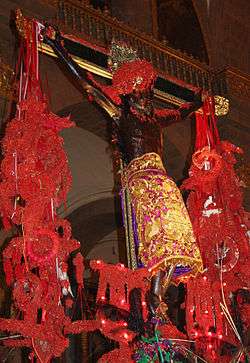Señor de los Temblores
in Quechua as Taytacha Temblores, is a statue of the crucifixion of Jesus from Cusco Cathedral in Cusco, Peru. The image is popularly believed to have placated any further disaster caused by the 1650 earthquake.[1] It became the patron saint of Cusco,[2] and is one of the most well-known images in Peru. It was created in Seville around 1570 and it is sent to the Viceroyalty of Peru, secured in an ark and secured on the deck of a ship destined to cross the sea and reach the port of Callao, from where it would be transferred to the city of Cusco, and is made of mixed materials, including sticks, plaques of agave fiber, and plaster. The black color is not the original tone but was created from centuries of smoke, dust, buildup of soot from candles and oil lamps, and pigment and pollen from the red ñuk'chu flowers that are showered on the statue when it is taken in procession on Holy Monday, and was not cleaned during restoration of the cathedral interior in the 1990s.[3]

Gallery
References
- Chaplik, D. (2005). Defining Latin American Art. McFarland & Company. ISBN 9780786417285. Retrieved 2014-10-09.
- E, V.E.V. (1991). Taytacha Temblores: patrón jurado del Cuzco. Consejo Nacional de Ciencia y Tecnología CONCYTEC. Retrieved 2014-10-09.
- Maya Stanfield-Mazzi, Object and Apparition: Envisioning the Christian Divine in the Colonial Andes (Tucson: University of Arizona Press, 2013).
- Brian S. Bauer (2004). Ancient Cuzco: Heartland of the Inca (First ed.). Austin: University of Texas Press. pp. 107–108. ISBN 978-0-292-75721-9.
- Alexander Bailey. Art of Colonial Latin America. London: Phaidon, 2005.
- "Terremoto del Cuzco y procesión del Señor de los Temblores". ARCA - Arte colonial americano.
